1980 CHEVROLET CITATION fold seats
[x] Cancel search: fold seatsPage 9 of 95
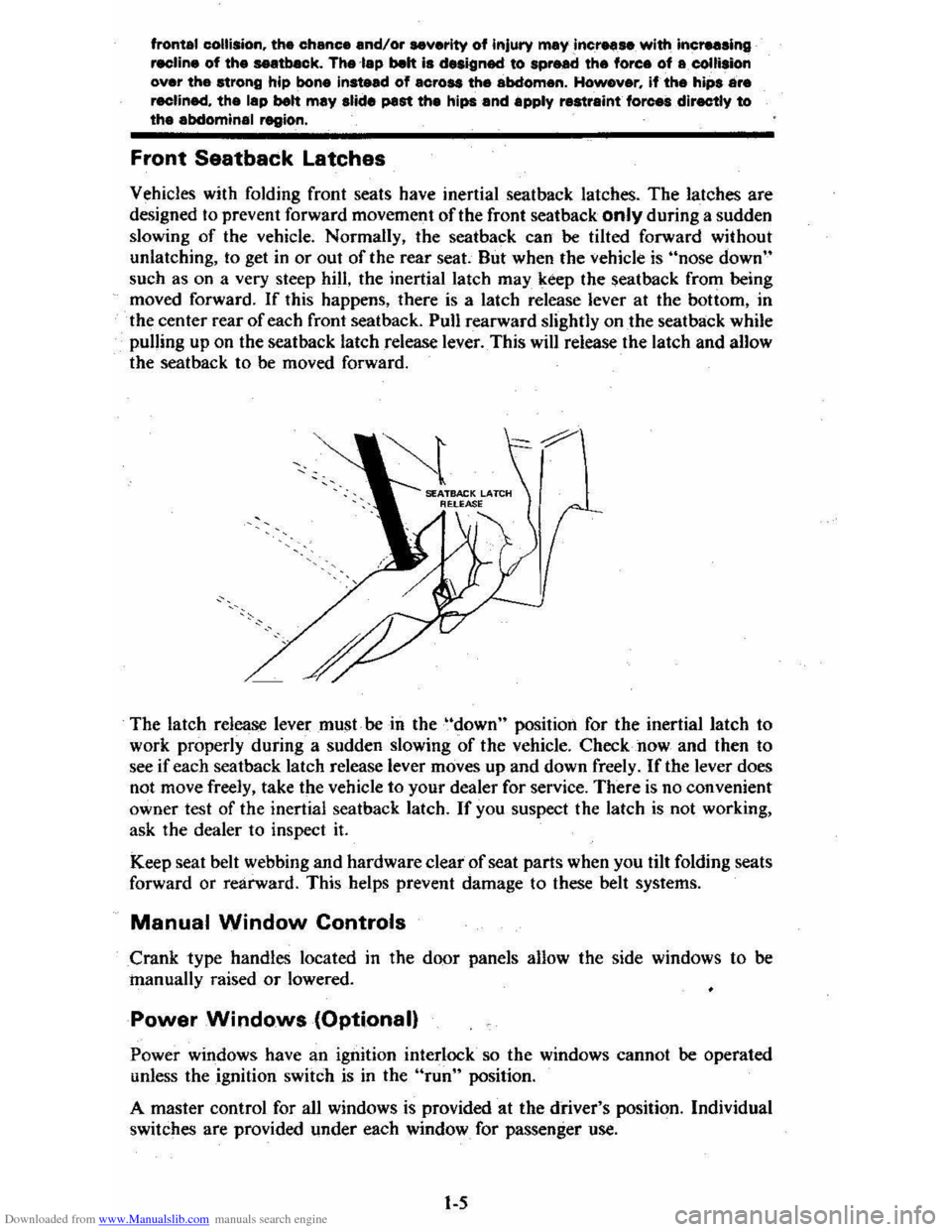
Downloaded from www.Manualslib.com manuals search engine frontal collision, the chance and/or severity of injury may increase with increasing
recline of the saatbeck. The -lap belt is d .. ignad to spread the force of a collision over the strong hlp bone instead of across the abdomen. However, if the hips are
reclined, the lap bett may slide past the hips and ilpply restraint forceS directly to the abdominal region.
Front Seatback Latches
Vehicles with folding front seats have inertial seatback latches. The latches are
designed to prevent forward movement of the front seatback only during a sudden
slowing
of the vehicle. Normally, the seatback can be tilted forward without
unlatching, to get in
or out of the rear seat. But when the vehicle is ""nose down"
such as on a very steep hill, the inertial latch may keep the seat back from being
moved forward. If this happens, there is a latch release lever at the bottom, in
the center rear
of each front seatback. pun rearward slightly on the seat back while
pulling up on the seatback latch release lever .. This will release the latch and alJow
the seat back to be moved forward.
The latch release lever must.
be in the "down" position for the inertial latch to
work properly during a sudden slowing of the vehicle. Checkrtow and then to
see
if each seatback latch release lever moves up and down freely. If the lever does
not move freely, take the vehicle to your dealer for service. There is no convenient
owner test of the inertial seatback latch.
If you suspect the latch is not working,
ask the dealer to inspect
it.
Keep seat belt webbing and hardware clear of seat parts when you tilt folding seats
forward or rearward. This helps prevent damage to these belt systems.
Manual Window Controls
Crank type handles located in the door panels anow the side windows to be
manually raised or lowered.
Power Windows (Optional)
Power windows have an ignition interlock so the windows cannot be operated
unless the ignition switch is in the "run" position.
A master control for all windows
is provided at the driver's position. Individual
switches are provided under each window for passenger use.
1-5
Page 42 of 95
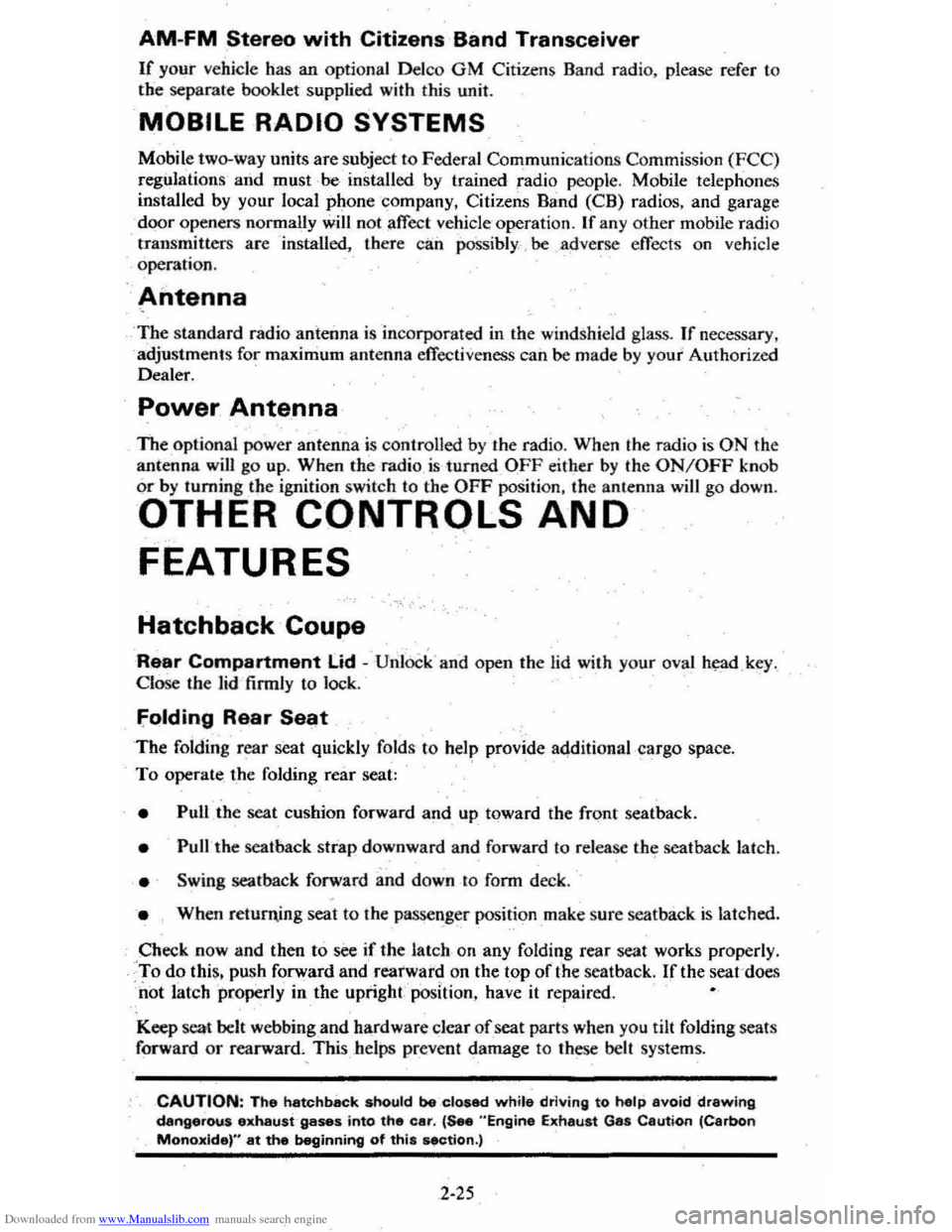
Downloaded from www.Manualslib.com manuals search engine AM-FM Stereo with Citizens Band Transceiver
If your vehicle has an optional Delco GM Citizens Band radio, please refer to
the separdte booklet supplied with this unit.
MOBILE RADIO SYSTEMS
Mobile two-way units are subject to Federal Communications Commission (FCC) regulations' arid must be-installed by trained radio people . Mobile telephones
installed
by your local phone 'company, Citizens Band (CB) radios, and garage
door openers normally will not affect vehicle operation.
If any other mobile radio
transmitters are installed, there can
possibly , be _ adverse effects on vehicle
operation.
Antenna
The standard radioanterma is incorporated in the windshield glass. If necessary,
adjustments for maximum antenna effectiveness can be made by your Authorized
Dealer.
Power. Antenna
The optional power antenna is controlled by the radio. When the radio is ON the
antenna will go up. When the radio is turned OFF either by the ON/OFF knob
or by turning the ignition switch to the OFF poSition, the antenna will go down.
OTHER CONTRQLS AND
FEATURES
Hatchback Coupe
·R.ear Compartment lid -UnlOCk.' and open the lid with your oval hta,d key.
Close the lid firmly to lock.
folding Rear Seilt
The folding rear seat quickly folds to heir provide aq.ditional ,cargo space.
To operate , the folding rear seat:
• Pull the seat cushion forward and up toward the front seatback.
• Pull the seatback strap downward and forward to release the:: seatback latch.
• Swing seatback forward and down to form deck.
• When return.ing seat to the passenger position make sure seatback is latched.
Check now and then to see
if the latch on any folding rear seat works properly.
'To do this. push forward andreat',wai'd on the top of the seatback. If the seat does
not latch properly in the upright. posttion, have it repaired.
Keep
seat belt webbing and hardware clear of seat parts when you tilt folding seats
forward or rearward , This .. helps prevent damage to these bell systems.
CAUTION: The hatchback should be closed while driving to help avoid drawing dangerous exhausigaS8s into the car. (See "Engine Exhaust Gas Caution (Carbon Monoxide)" at the beginning of thi. section.)
2-25
Page 66 of 95
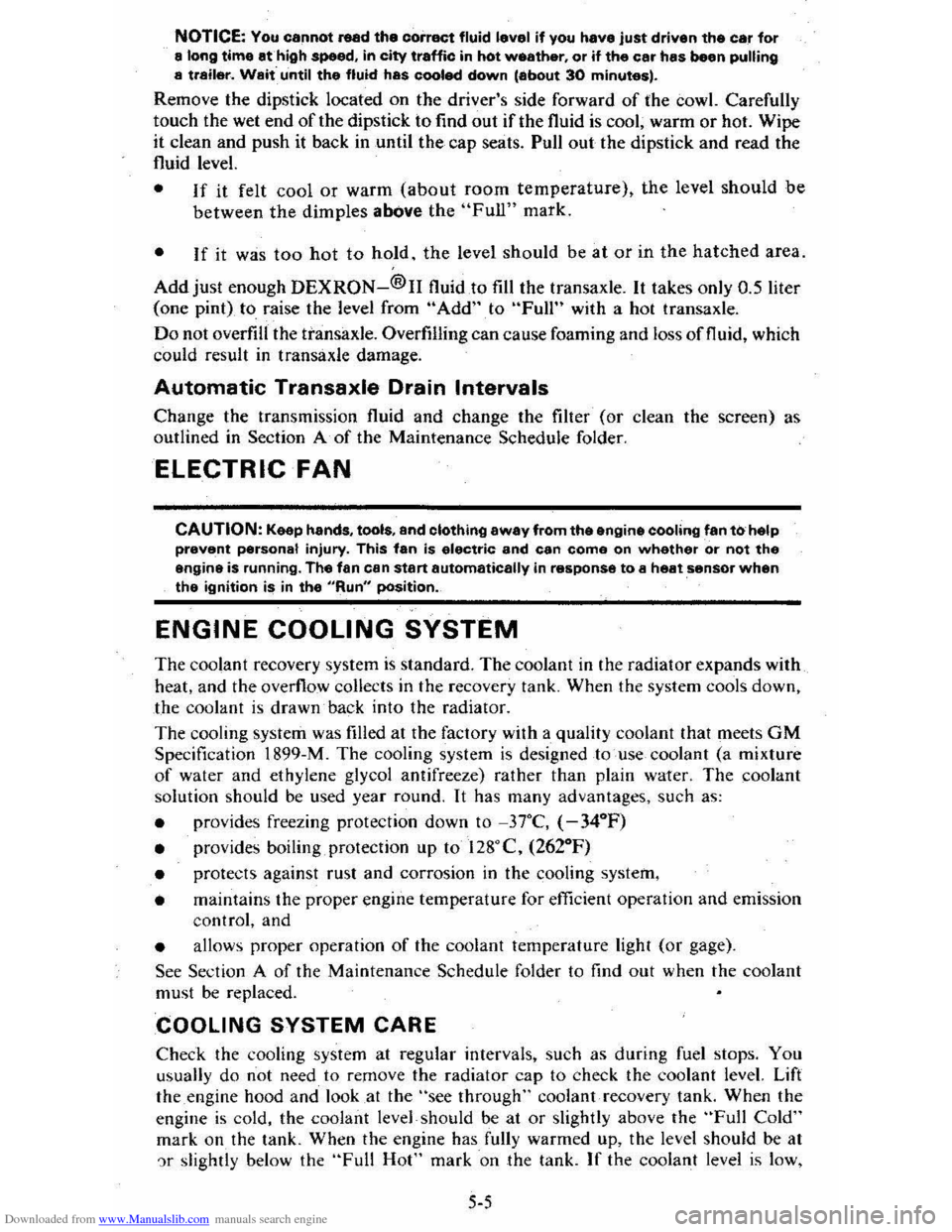
Downloaded from www.Manualslib.com manuals search engine NOTICE: You cannot read the correct fluid level if you have just driven the car for a long time at high speed, in city traffic in hot weather, or if the car has been pulling a trailer. Wait. until the fluid has cooled down (about 30 minutes).
Remove the dipstick located on the driver's side forward of the cowl. Carefully
touch the wet end of the dipstick to find out if the fluid is cool, warm or hot. Wipe
it clean and push it back in until the cap seats. Pull
out the dipstick and read the
fluid level.
• If it felt cool or warm (about room temperature), the level should be
between the dimples above the "Full" mark.
• If it was too hot to hold. the level should be at or in the hatched area.
Add just enough DEXRON-®n fluid to fill the transaxle. It takes only 0.5 liter
(one pint)to raise the level from "Add" to "Full" with a hot transaxle.
Do not overfill the transaxle. Overfilling can cause foaming and loss of fluid, which
could result in transaxle damage.
Automatic Transaxle Drain Intervals
Change the transmission fluid and change the filter (or clean the screen) as
outlined in Section
A of the Maintenance Schedule folder.
ELECTRIC FAN
CAUTION: Keep hands, tools, and clothing away from the angine cooling fan to help prevent personal injury. This fan is electric and can come on whether or not the engine is running. The fan can start automatically in response to a heat sensor when the ignition is in the "Run" position.
ENGINE COOLING SYSTEM
The coolant recovery system is standard. The coolant in the radiator expands with
heat, and the overflow collects in the recovery tank. When the system cools down,
the coolant
is drawn back into the radiator.
The cooling system was filled at the factory with a quality coolant that meets
GM Specification 1899-M. The cooling system is designed to use coolant (a mixture
of water and ethylene glycol antifreeze) rather than plain water. The coolant
solution should be used year round. It has many advantages, such as:
• provides freezing protection down to _37°C, (-34°P)
•
provides boiling protection up to 128QC, (262°P)
•
protects against rust and corrosion in the cooling system,
• maintains the proper engine temperature for efficient operation and emission
control, and
• allows proper operation of the coolant temperature light (or gage).
See Section A of the Maintenance Schedule folder to find out when the coolant
must
be replaced.
COOLING SYSTEM CARE
Check the cooling system at regular intervals, such as during fuel stops. You
usually do not need to remove the radiator cap to check the coolant level. Lift
the engine hood and look at the "see through" coolant recovery tank. When the
engine
is cold, the coolant level -should be at or slightly above the "Full Cold"
mark on the tank. When the engine has fully warmed up, the level should be at ')r slightly below the "Full Hot" mark on the tank. If the coolant level is low,
5-5
Page 90 of 95
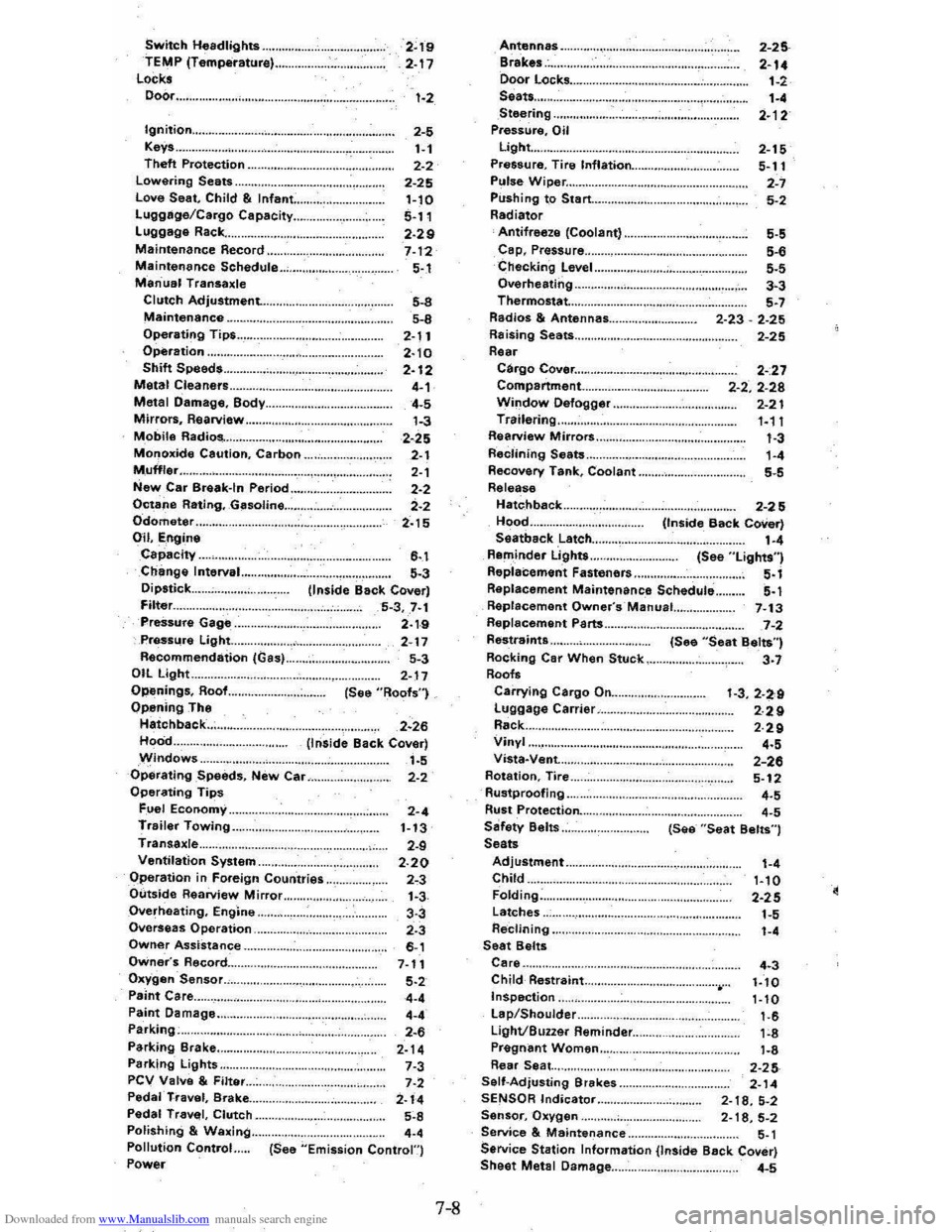
Downloaded from www.Manualslib.com manuals search engine Switch Headlights .... TEMP (Temperature) .. Locks Door ...
2~19 2-17 1-2
Ignition ............................................. .. 2-5 1-1 2-2
2-25 Keys .. Theft Protection .. Lowering Seats .. Love Seat, Child & Infant: .. Lugglige/Cargo Capacity ... Luggage Rack ... Maintenance Record .. Maintenance Schedule .. Manual Transaxle Clutch Adjustment. .. .
1-10 5-11 2·29 7-12 5-.1
Maintenance ........................................... . 5-8
5-8
2-11
2· 10 2-12 4-1 4-5
1-3
Operating Tips .. Operation .. Shift Speeds. Metal Cleaners .. Metal Damage, Body ... Mirrors, Rearview .. Mobile Radios-. Monoxide Caution, Carbon .. . 2-25 2-1
2-1 2-2
2-2
2-15 Muffler ............................................... . New Car Break-In Period Octane Rating, Gasoline ... Odometer Oil, Engine Capacity .. Change Interval.. Dipstick ... Filter ... PreSsure Gage .. Pressure Light... Recommendation (Gas) .. OIL Light.. Openings, Roof... Opening The Hatchback ... Hood .. Windows ..
6-.1 5-3 (inside Back Cover) 5-3,7·1 2·1-9 2-17
5-3
2-17 (See "Roofs")
2·26 (Inside Back Cover) 1-5 Operating Speeds, New Car... 2-2 Operating Tips Fuel Economy.. 2-4 Trailer Towing.. 1-13 Transaxle... 2-9 Ventilation System.. 2.20 Operation in Foreign Countries.. 2"3 Outside Rearview Mirror.. 1.3 Overheating, Engine.. 3-3 Overseas Operation.. 2.3 Owner Assistance.. 6-1 Owner's Record... 7-11 Oxygen Sensor., 5.2 Paint Care.. 4-4
Paint Damage .. Parking;. Parking Brake .. Parking Lights .. PCV Valve & Filter .. Peda'·TI"avel, Brake ... Pedal Travel, Clutch .. Polishing & Waxing .. Pollution Control Power
4-' 2-. 2-14 7-3 7·2 2-14 5~8
.-. (See "Emission Contron
7-8
Antennas Brakes .. Door Locks .... Seats ... Steering Pressure, Oil Light ... Pressure. Tire Inflation ... Pulse Wiper ...
2-25
2-14
1-2 1-' 2·12
2-15
5-11
2-7
Pushing to Start ................................ .. 5-2 Radiator Antifreeze (Coolant) .. Cap, Prassure .. Checking Level .. Overheating .. Thermostat...
Radios & Antennas ... Raising Seats ... Rear Cargo Cover ...................... .. Compartment .. . Window Defogger .. Trailering .. Rearview Mirrors .. Reclining Seats .. Recovery Tank, Coolant .. Release
Hatc.hback
Hood .. Seatback Latch ... Reminder Lights ....
Replacement Fasteners
5-5 5-. 5-5 3-3 5-7
2-23 -2-25
2-25
2-:27
2-2,2-28 2-21 '·11 1-3 1-' 5-5
2-25 (Inside Back Cover)
1-' (See "Lights") 5-1
5-1 Replacement Maintenance Schedule .. Raplacement Owner's·Manual... 7-13 Replacement Parts ............. ....................... 7-2 Restraints .. Rocking Car When Stuck .. Roofs Carrying Cargo On ... Luggage Carrier .. Rack .. Vinyl .. Vista-Vent. ... Rotation, Tire .. Rustproofing .. Rust Protection ... Sefety Belts .. Seats (See
"Seat Belts") 3-7
1-3,2-2,9 2·29 2·29
'-5 2-26 5-12
'-5 '-5 (See "Seat Belts")
Adjustment.. 1-4 Child... 1-10 Folding.. 2-25 Latches..
1-5 Reclining.... . '-4 Seat Belts Care.. 4.3 Child Restraint ............................................ 1.10 Inspection.. 1-10 Lap/Shoulder.. 1-6 Light/Buzzer Reminder... 1;8 Pregn~nt Women .. Rear Seat. ... Self-Adjusting Brakes .. SENSOR Indicator ..
1-8 2-25 2-14 2-18,5-2 Sensor, Oxygen.... 2-18,5-2 Service & Maintenance.. 5-1 Service Station Information (InSide Back Cover) Sheet Metlll Damage... 4-5
Page 91 of 95
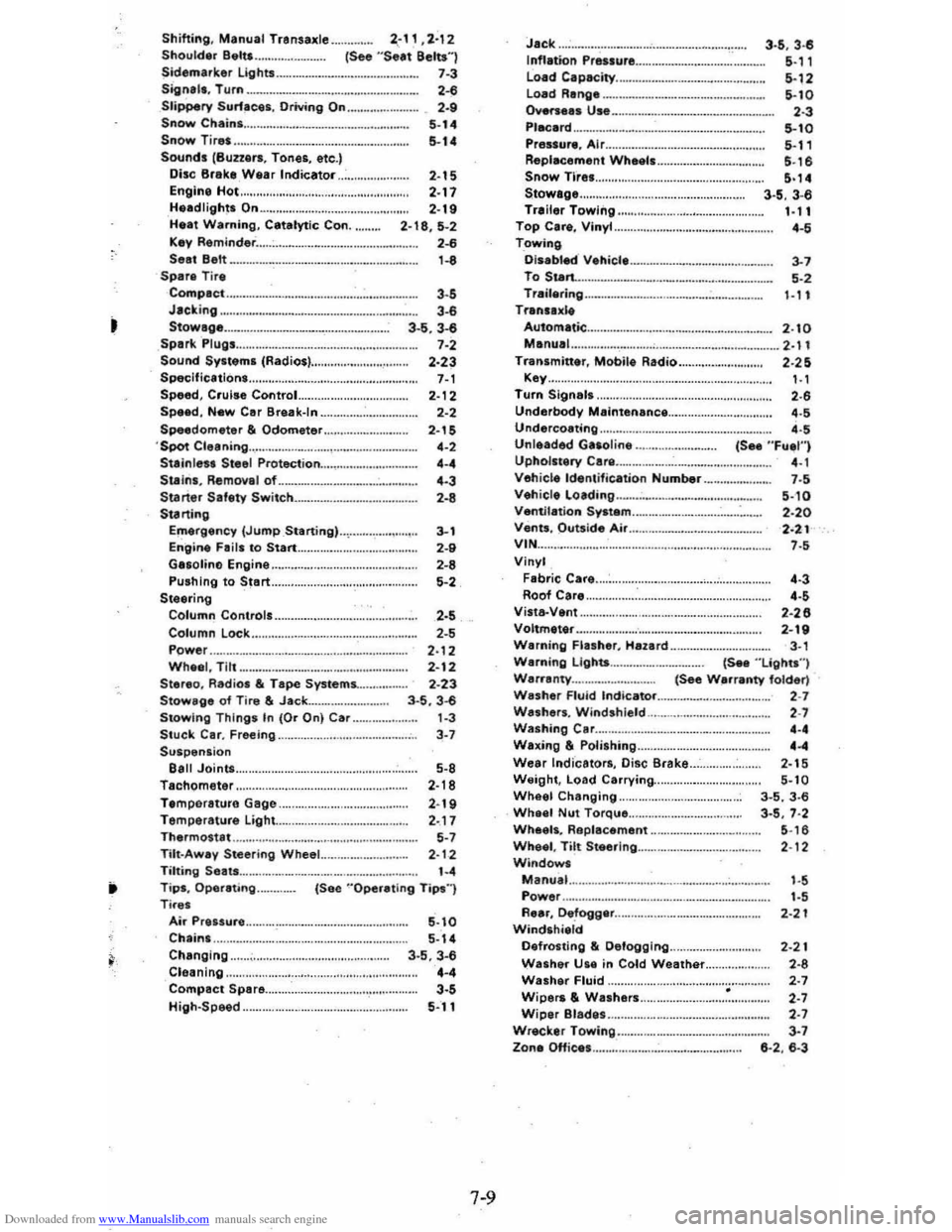
Downloaded from www.Manualslib.com manuals search engine ,
Shifting, Manual Transaxle .. Shoulder Beltt .. 2~1 1 ,2'12 (See "Seat Belt$"J Sidematker lights Signala, Turn ...................... 7·3 ......... ... . . ..........•...•. 2-6 Slippery SUffices. Driving On .. Snow Chains Snow Tires Sounds (Buzzers, Tones, etc.)
, .. 5·14 5-14
Disc Brake Wear Indicator .... 2-15 Engine Hot... 2-17 Headlights On ................. ....................... .... 2-19 H .. t Warning, Catalytic Con. 2·18 ,5-2 Kay Reminder . .................................. ...... 2-6 Sell eelt 1-8 Spar. Tire Compact .......................... 3 .5 Jaeking .... ............................. .. . 3-6 Stowage ...................... _ ....... ........ .......... 3·5. 3-6 Spark Plugs .. .......... .......................... ........... 7-2 Sound Systems (Radios). 2.23 Speclficllions.. ...................... 7-1 Speed, Cruise Control.................... . 2-I 2 Sp .. d, New Car Break-In ............................. 2-2 Speedometar & Odometar ... 'Spot Cleaning
Staln le .. Steal Prtltect ion ........ .. S .. ln •• Removel of Staner Safety Switch .............. _ ..... . Starting E",ergency (Jump Staning) Engine F.ill to Stan ................ .............. ..
2-15 ,.,
,.,
'·3 ' ·8
Ga.olino Engine.. . .......................... .
3·, , ..
'·8 5·' Pushing to Start .. Steering Column Contrail ..................... .................. . '·S '·5 2·12 2 -12 2·23
Column Lock .. Power ......................... . Whee l, Tilt ......... ........................ ....... .. Siereo, Radiol & Tape Systems. Stowage of Tire & Jack ... Stowing Things In (Or On) Car .. Stuck Car. Freeing .. Suspenlion eall Joints ................................ ....... .. Tachometer ........ ................................ ....... .
3 ·5 . 3-6 ,·3 3·'
5·8 2·18 Temperature Gage .................. ............... 2-19 Temperature Light. .. 2 ·17 Thermostat ......... ....... ....... 5-7 TiIt·Away Steering Wheel.. 2 ·12 Tilting Seats... '·4 T ip', Operating.. (See "Oper.tlng Tips ") Tire.
Air Preuure ..... ......... ................................ . Ch.in •... Ch.nglng .. Cle.nlng .. Compacl Spara ......................... ....... . High·Speed ..
5·10 5-14 3·5,3-6 '·4 3·S 5-11
7-9
Jack 3-5 , 3·~ Inflation Pre .. ure ................. .... ......... ........ 5·" Load Capacity ............................. 5-12 Load Range 5-10 Overse •• Use ... 2-3 Placard ... Pres.u,., A ir ..................... ....................... . Repl.cement Wh.ell ............................ . . Snow nte ........... . Stow.ge ............... . Trailer Towing .. Top C.r., Vinyl ..
TowinQ
Disabl-.:t V.hicle To S .. rt. Tr.il.ring ....... . Tr.n.ax'"
5·10 5 ·1, 5,,6 5·14 3·$ ,3-6 1 ·11 4.'
3·'
S ·'
1·11
Autom.tic...... .......... .. .............. ....... 2.10 Manu.l.. . ...... ; . ................... .................. 2 .' 1 Tr.nlmitt.r, Mobile Radio 2 .25 Key. . ..................................... . ..... 1.1 Turn Signall.... ................................................. 2.6 Underbody Maintenance ............................... 4.5
Undercoating... ... ................................. ............ 4.5 Unleaded G •• oline (See "Fu~1") Uphollt.ry Care ................... ... 4 .1 Vehicle ldentifi~tion Number ._............. 7 .5 Vehicl. Lo.ding .. _ Ventil.tion System .. Vents , Outside Air ... V'N Vinyl F.bric C.r •.
5·10 2·20 2 .21 ' ·S
Roof Care ................. ................................. ..... . '·3 ,., Vilta-V.nt ....... . Voltm.t.r .. 2 ·26 2·'V 3 ·' Warning Flasher , Hazard .. Warning Lights ... W.rr.nty .... (See "Light.")
Washer Fluid Indicator W.shers. W indshield. Washing C.r ....
(See W.rranty folder) ,.,
, .,
, ., W.xing & P olilhing .. Wear lndi'c.tor., Disc Srake .. Weight, Load Carrying ... Wheel Changing .. Whaal Nut Torque .. Wh.el., Repllcement ........................ _ .. Wheal, Tilt Sleerlng ... Windows M.nu. 1 Power , ... , ............................. ..................... . . RUr, De.fogg.r .. . Windshi.ld Defrosting &; Defogging .. W.sher Ule in Cold Weather ... Walh.r Fluid .. Wipers & Wa.hers .. Wiper Blades .. Wreck.r Towing .. Zona OHic.s ......... " ............... ....... .
'·4 2·15 5 ·10 3 ·5 ,3 ·6 3 ·5 , 7·2 5 ·16
2 ·12
'·S
' ·S
2 ·2t
2·21
2 ·8
,., , ., , .,
3 ·' 6 ·2 . 6·3